SOME REFLECTIONS. . . NOT THAT IT’S OVER
/2 Comments/in Gardening, Pests, Vegetables/by Lee ReichFinish Squash
“Zucchini bread is for people who don’t have compost piles.” That’s what I told Deb after she suggested, first ratatouille, and then zucchini bread, as vehicles for our excess zucchini.
Most years I make an early, too large planting of zucchini (about 6 plants), and then, six to eight weeks later, make another sowing of only a couple of plants. The first planting puts enough zucchinis into the freezer for winter, as well as leaving enough for eating. The second planting is to yield an occasional zucchini for fresh eating through summer after plants of that initial planting have succumbed to squash vine borer, cucumber beetles, bacterial wilt, and any of the other maladies that usually do in the plants a few weeks after they begin bearing. Usually and thankfully do in the plants. But not this year.
Almost every time I check that early planting of zucchini, a new fruit has swelled at the end of a vine now trailing beyond its bed beneath stalks of popcorn in an adjacent bed. I feel no obligation to eat zucchini, whether in zucchini bread, ratatouille, or any other concoction.
Where Are the Insects?
In all my decades of gardening, I’ve never experienced a season with so few insect pests. A few Japanese beetles reared their ugly heads back in July; they were the only ones who showed up, except for an occasional straggler. Likewise for bean beetles. Eggplants hosted the few requisite flea beetles, but never enough for concern. (I did spray a few times with horticultural oil; judging from other gardeners’ flea beetle-less experiences this year, doubt that the effect was from the oil.)
Cabbageworms, always requiring some late summer action on my part in the past in the form of one or two sprays of the biological insecticide Bacillus thurengiensis, have let me occupy that time with other things.
Spotted wing drosophila, known non-affectionately as SWD, showed up, as usual, in sufficient numbers in early August to warrant a spray of spinosad, an extract from a naturally-occuring bacteria found in the soil of a defunct rum factory in the Virgin Islands. That one spray, along with some experimental traps from Cornell, was sufficient to keep the buggers from using my blueberries as nurseries in which to raise their young.
As is so often the case with complex systems, in this case involving the vagaries of this season’s weather, the biology and the chemical and physical make-up of the soil, interactions between garden plants as well as between garden plants and weeds, timing of plantings . . . what I’m trying to say is that I have no idea why the year was so auspicious, as far as insects.
Here Are the Diseases
That was insects. Diseases are another story. Don’t look at my tomato plants.
The tomato plants started the season neatly and decoratively trained as single stems up bamboo poles, soon clothing those poles in lush, green leaves and red or orange tomatoes. Now? Stems are pretty much bare from ground level up a couple of feet, with some shriveled, brown remnants of leaves dangling downwards. The disease is not fusarium or verticillium, to which so many modern tomato varieties are touted for being resistant.
The affliction is leaf spot disease, which is actually one or more of three diseases: early blight, septoria leaf spot, and/or late blight. The worst of the three is late blight, which makes us gardeners and farmers especially nervous after a severe outbreak ravaged a large swath of the Northeast a few years ago. Air currents and humidity have not been favorable this year for late blight to hitchhike up from the South, where it overwinters, and any that might have reached here couldn’t get footholds with this season’s hot, dry weather.
Thorough cleanup of old leaves and stems, which house early blight and septoria leaf spot through the winter, and planting tomatoes where they haven’t been plant for the previous two years, was supposed to keep these diseases in check. Perhaps it did, but not enough.
I have two vegetable gardens, and next year I’ll plant tomatoes in the one that housed no tomatoes for the past couple of years, putting more distance between overwintering disease spores and my plants. Clean up and distance should also quell one other disease, anthracnose, responsible for sunken, rotting areas that develop on some of the fruits.
Diseases notwithstanding, plenty of glass jars filled either with sparkling red, canned tomatoes and dull red, dried tomatoes line shelves to bring some essence of summer into through the dark months ahead.
Pepper Heaven
Tomatoes may be the essence of summer for their ubiquity in gardens; for me, though, ripe, red peppers more represent a summery flavor. My peppers rarely experience insect or disease problems. The challenge, this far north, is ripe, red peppers in abundance.
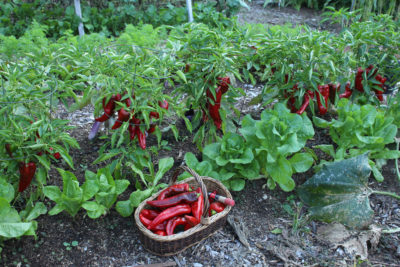
Italian Sweet peppers
My favorite variety for flavor, earliness, and productivity, especially this far north, is Italian Sweet. I put in many plants this past spring, and the harvest is prolific.
Unfortunately, dried or frozen peppers offer only wan hints of the fresh peppers’ summery flavor and texture.
BACTERIA AND FUNGI, AND GRAPES, OH MY
/7 Comments/in Fruit, Gardening, Pests/by Lee ReichUpcoming Fall Fruit Workshop
See web page https://leereich.com/workshops for details.
The River Runs Green
Crossing the bridge over the Wallkill River on my way home, I glance to my right to admire the river itself. What a beautiful color it has turned, a bright turquoise. Ponds I pass also have taken on this bright complexion, for which we can thank, or curse, organisms known as blue-green algae (heretofore referred to as BGA).
Algae, they are not, though. BGA are bacteria known as cyanobacteria. “Algae” generally refers to eukaryotes, organisms with distinct nucleii and specialized organelles. BGA are prokaryotes, lacking such features.
BGA can be toxic, which is good reason to curse them. Drinking or swimming in contaminated waters can cause problems to humans and other animals, including dogs, who seem to be otherwise able to drink almost any water without ill effect. The “cyan” in the name and the criminal cyanotoxins are not at all related to cyanide. The name come from “cyan,” which is the color blue-green.
Many kinds of BGA are found throughout the world, often in extreme conditions. Not all produce cyanotoxins; some produce them only under certain conditions. Not all are even blue-green; the Red Sea gets its color from Trichodesmium erythraeum, a species of BGA. Certain conditions cause “blooms,” such as those I was admiring in the river and ponds. Here, it’s probably a combination of relatively dry conditions resulting in shallow and calm waters along with the usual influx of nutrients, mostly phosphorus and mostly from farms, septic systems, and lawns.
BGA are photosynthetic organisms, just like plants, imbibing carbon dioxide during the day and spewing out oxygen. These primitive organisms, “in the beginning,” were important for oxygenizing the Earth’s atmosphere, thus stimulating biodiversity. We could praise them for sequestering carbon.
Agriculturally, some cyanobacteria are important because they can convert atmospheric nitrogen into forms of nitrogen that plants can use. Although these cyanobacteria are especially important for maintaining fertility of rice paddies, they are present, to some degree, in virtually all soils. Some research even points to benefits of inoculating soils with these organisms.
Bags vs. Fungi
So now I’m home, my head out of the soil, and admiring my grape vines. The dry weather has been almost as good for the grapes as it has been for the cyanobacteria. Dry weather minimizes grape diseases and abundant sunlight puts flavor and sweetness into the berries. With annual applications of mulch around the grapes and their far reaching roots, I never worry about my established vines being thirsty.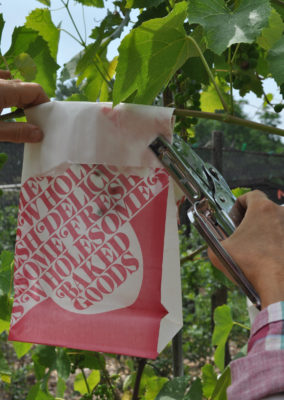
Back in early summer, we went to the trouble of affixing paper “delicatessen” bags around 100 bunches. Now is the payoff. Peeling back the paper usually reveals perfect, full, bloom-dusted bunches of especially delectable grapes. “Especially delectable” because I can let these protected bunches hang longer on the vines than unbagged bunches, which do have some disease and are prey to bees, wasps, and birds. These bagged grapes get dead ripe before being harvested.
The bagging isn’t really all that troublesome. We just select downward hanging bunches, made easier because I train fruiting canes horizontally across a 5-wire, flat trellis, and remove any tendrils or leaves opposite the bunches. After making a slit down each side of a bag, the slitted opening is slid up the cane on either side of the bunch, the top of the bag is folded over, and then the flap stapled down on either side — well worth the minute or so it takes from selection to finish bagging a bunch.
Grapes to Keep
With many varieties of established grapevines, I can cut down any whose flavor is not up to snuff or that don’t produce well without having to bemoan waiting for new ones to start bearing. The “keepers” tide me over. Variety choice is somewhat limited here because of winter cold and because cooler, damp air collects in this valley, promoting disease, abetted by inoculum from all the wild grape vines grappling high into neighboring trees along the forest edge.
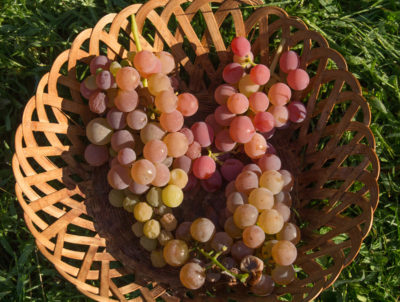
Glenora and Vanessa seedless grapes
I’ll be doing a Henry IVth on Mars and Concord.
Some of my current favorite varieties are Vanessa, Somerset Seedless, and Glenora, all seedless varieties. Of the three, Glenora has the best flavor, Vanessa the best texture, but they’re all very good. Some of my favorite seeded varieties are Alden, whose corpulent berries hang in large bunches, and Brianna, which isn’t quite ripe yet, but every year has rewarded us with foxy-flavored, pale green berries.
Still to come for this season are Edelweiss, which has a rich, very foxy flavor but has not been very productive the last few years, and Brianna, with its own rich flavor not so dependent on foxiness.
A few more years of tasting and watching will dictate whether New York Muscat, Cayuga White, Bertille Seyve 2758, Lorelei, Reliance, Swenson White, and Wapanuka keep their home here. They’re all good grapes, but why grow good grapes when I could grow great grapes from among the 5,000 or so varieties (not all adaptable here, of course)?
(That “foxy” flavor I kept referring to is characteristic of many American grapes, and is typified by the variety Concord. No one is sure how “foxy came to describe that flavor.)
DRY WOOD, & AUTUMNAL AIR
/3 Comments/in Design, Flowers, Gardening, Planning, Soil, Vegetables/by Lee ReichPassionflower to the Rescue
When I began, many years ago, to heat my home with wood, I struggled to get the driest possible wood, finally building a 60-foot long woodshed beneath which a double row of logs basked in the direct hit of sunlight from the south. I more recently learned that firewood can be too dry, which is when moisture drops below 15 to 20 percent. Bone dry wood can’t get enough oxygen for a clean, efficient burn, so smoke, within which is locked the potential for rendering additional heat, is produced; pump enough oxygen into the mix, though, and you get an inferno that can damage a woodstove.
So — and here’s the plant-related part — rather than tear down or put siding on my super-drying woodshed, I put some heat loving vines to climb and provide some shade on the south face. Sections of hog-fencing temporarily hung on hooks just below the roof in front of each of the 8 foot bays support the vines.
Maypop, Passiflora incarnata, is an ideal candidate for this location. (Learn more about maypop — a whole chapter’s worth! — Uncommon Fruits For Every Garden.) It’s an herbaceous perennial, emerging early each June to grow vigorously into lanky vines 10 or more feet long. Maypop is a hardy species of passionflower, and a few weeks after emerging, the intricate blue or white blossoms unfold along the stems.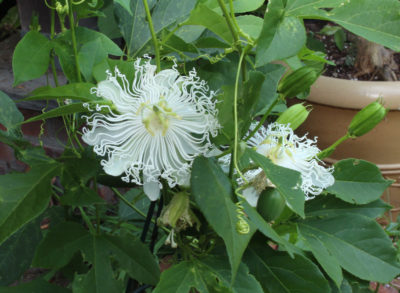
Flowers would be enough, but there’s more. A few weeks later, those flowers morph into egg-shaped fruits: tropical passionfruits this far north.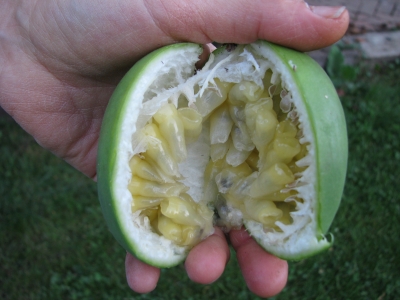
In southeastern U.S., maypop, with its spreading root system, is considered a weed. This far north, maypop will enjoy the extra heat of the microclimate at the south face of the woodshed. The woodshed itself will contain the plant in its travel northward. The lawnmower will contain the plant in is travel southward. Let it spread all it wants east and west along the base of the shed.
Morning Glory & Kin for Quicker Effect
In spring I planted a maypop plant at the foot of four of the woodshed bays. As a perennial, maypop needs time to get established. Because I went to the trouble of hanging a trellis from each of the bays, I wanted something to clothe even this summer.
Enter the Convolvulaceae family, which counts morning glory among its kin. Less know, but also kin and vines with pretty flowers, are cardinal vine and moonflower. I figured that some member of this family could accompany maypop in each planting hole.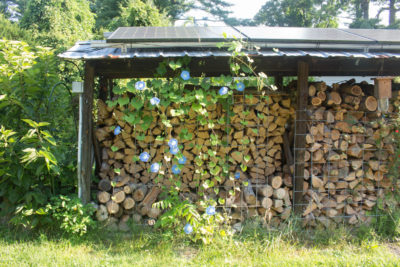
All three Convolvulaceae family members grow vigorously so could provide good coverage for the woodshed. They also integrate well with each other, design-wise. Morning glory wakes up early, its sky-blue flowers opening each morning to foreshadow the blue sky that lies ahead. (The flowers remain furled under overcast skies.) Once the sun rises high in the sky, fire-engine red flowers of cardinal flower take the torch for the remainder of the day. As night falls, moonflowers’ large, white trumpets open and emit their sweet scent.
This year, those annual vines grew so vigorously that they stunted their companion maypops. Next year will be better. Also, a couple of plants of another vine, native and somewhat decorative, have tried to get a foothold in the planting. Poison ivy, you’re not welcome here.
Autumnal Readiness
Morning glories have started lingering later into the mornings, a sign that autumn is approaching. I’m also getting signals — a softness in the air and an occasional chill, a slight chill — of autumn’s approach. Those signals do not have me lingering late in the morning, though.
The imminence of autumn has me scurrying around making sure all is copacetic in the weeks to come and on into next year. Turnips and winter radishes have been thinned. Cabbages, Chinese and European, transplants are growing well, hinting at crocks of kim-chi and sauerkraut to come. Onions have been harvested and woven into ropes for storage, now in the garage, later in the basement.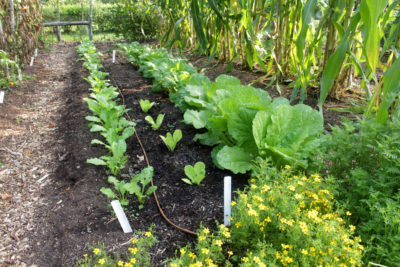
Any cleared vegetable bed is given a thorough weeding and then an icing of an inch depth of compost. That compost will snuff out small weeds attempting to sprout below. Additionally, it will feed soil microbes which will, in turn, feed plants for at least a year. I’ll sow arugula, mustard greens, and “spring” radishes in the bed which I recently cleared of sweet corn, weeded, and composted.
A couple of sites have been prepared for two new trees. “Prepared” is too fancy a word; all I did was pile mulch on the ground at both locations. The mulch will kill existing vegetation and leave soft, moist ground for easy planting in October.
Autumn will be bountiful and next year will be a good year.

